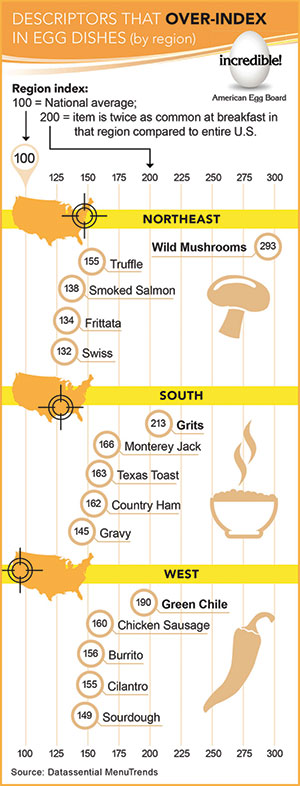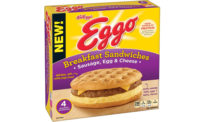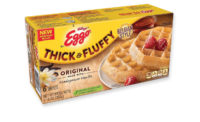Early last year, when offbeat eateries like San Francisco’s Trouble Coffee & Coconut Club began serving $4 slices of thick-cut, artisanal toast, simply slathered with house-made butter or other “small-batch” spreads, U.S. food culture took quick notice. This was dialed-down, cottage-industry charm and simplicity—local, rustic breads particularly suited to toasting. These foods have a face and a name.
While initially the toast trend rightly faced its fair share of skepticism, it resiliently took hold. The concept resonated and continues its spread its influence far and wide. It was only a matter of time before the idea of toast manifested itself in myriad ways across the food industry. Now it’s the hot flavor profile du jour, still testing its legs across multiple food categories.
While toast is far from the only trend plying its influence on the morning day part, it serves as a strong representation of the multiple avenues within food reshaping breakfast today: touching on a quest for simplicity, nebulous desire for an “artisan” touch, a small slice of indulgence. The new face of breakfast also regularly brings a subtle—and intentional—better-for-you approach.
Shifting perspectives
Prevailing breakfast patterns of late have seen several categories vie for increased market share, while others fade from prominence. Even though ready-to-eat (RTE) cereal remains a financial powerhouse, taking in $8.5 billion annually per the August 2014 “Breakfast: Still the Most Important Meal of the Day” report from The Nielsen Co., it continues to slip. Breakfast revenue is actually on an upswing, but RTE cereal sales continue to decline.
Meanwhile, Nielsen notes, sales of frozen waffles, pancakes and French toast—a $1.2 billion category—have seen a 4.5 percent compound annual growth rate (CAGR) over the past five years. The in-store bakery, valued at $3.2 billion, has also seen an upswing, with a CAGR of 4.1 percent.
IRI, Chicago, reports gains for multiple baked goods for the 52 weeks ending Feb. 22, 2015: doughnuts were up 7.35 percent in dollar sales; muffins, 5.49 percent; English muffins, 4.67 percent; pastry/Danish/coffee cake, 3.34 percent; and bagels, 1.77 percent.
And over in the deli, Nielsen notes, breakfast sandwiches have spearheaded a 7.9 percent CAGR, to $104.7 million.
Bar culture
Bars are also on the rise. Over the past 10 years, three of the four breakfast foods showing the fastest rate of increasing popularity were healthy, portable snacks like cereal bars, according to the February 2015 “Nutritional and Cereal Bars in the U.S., 4th Edition” report from Packaged Facts. The firm notes that bars are projected to approach $8 billion in 2019, a growth of 30 percent and a CAGR of 5 percent.
“Convenience is key—a single-serve-size pack that you can grab, throw in a bag and is easy to open are among the first things that are considered,” says Ricardo Rodriguez, bakery and confectionery marketing manager, Ingredion Inc., Westchester, IL. And the influence of “clean label” extends to bars. “Consumers are more knowledgeable than ever and are taking the time to read what ingredients are used and what functional benefits they are getting.”
The bars segment is crowded, so building in wide appeal helps. “As consumers are shifting their breakfast habits, there is an opportunity for snack and bakery manufacturers to create breakfast products, including bars, that appeal to a wide audience,” says Molly Spence, regional director, North America, the Almond Board of California, Modesto.
According to the September 2014 “U.S. Bars Exploratory Study” by the Sterling-Rice Group, 20 percent of respondents choose snack and cereal bars for breakfast. “Convenience is key, with over 40 percent of respondents indicating that they eat bars at school or work, or during their commute,” Spence says. “The same survey also found that consumers selected almonds as their preferred ingredient nut in cereal and snack bars.”
The July 2014 “Moments Matter: Motivations Behind Snack and Breakfast Bar Occasions” study from Insights Now Inc., found 21 percent of consumers had consumed a bar with almonds as a breakfast meal replacement in the past three days.
“Almond butter can be used as a clean label-friendly binder that brings a nutty creaminess to a bar formulation,” says Spence. “Diced almonds add distinct crunch, while sliced almonds can lend more of a chewy texture. With so many forms to choose from, manufacturers have the freedom to select which form will result in the desired texture for the finished product.”
Cookies for breakfast
Cookies are also for breakfast these days. Mondelez International, Deerfield, IL, helped shape the breakfast cookie category with Nabisco belVita Breakfast Biscuits—a line that recently saw the addition of bite-sized options in Chocolate and Mixed Berry. A key point of attraction for belVita is its claim of sustained energy thanks to a proprietary mix of grains and formulation tactics that yield a slow release of energy for hours after consumption.
In the wake of belVita’s success, others have tested the breakfast biscuit/cookie market. Post Foods launched Honey Bunches of Oats Breakfast Biscuits, made with 100 percent whole grain, billed as providing “long-lasting energy” and offering 4 grams of fiber and 5 grams of protein. Available flavors include Honey Roasted, Strawberry and Chocolate.
PepsiCo has also entered the breakfast cookie game with its vanilla-flavored Quaker Oat & Yogurt Sandwich Biscuits—a product in the vein of a sandwich cookie, but one the company specifically recommends for breakfast—which offer 10 grams of whole-grain oats per serving and provide a “good source” of fiber. Quaker also offers a hearty Oatmeal Chocolate Chip Breakfast Cookie that is a “good source” of iron, calcium and fiber.
Toaster time
The market is ripe for artisan-style breads suited to the toaster. Ozery Bakery has released Morning Rounds, fruit and grain buns clearly designed for toasting, in Muesli (mixed grains, apples, raisins, sunflower seeds and flax seeds) and Cranberry Orange and Date & Chia (chia seeds, dates and sunflower seeds). The grain mix at play in the Muesli product includes cracked wheat, cracked rye, millet meal, cracked triticale, barley grits, rolled oats and durum semolina.
Familiarity remains a strong driver. Even the most classic of toaster items is seeing a shift. In an effort to cultivate new interest in toaster pastries, The Kellogg Co. recently added Gone Nutty! products to its Pop Tarts line with Chocolate Peanut Butter, Peanut Butter and PB&J Strawberry flavors.
And the omnipresent celiac angle? Gluten-free is an area of growth for toaster pastries. Boulder Brands toaster pastries, offered by Glutino, were up 73.50 percent in dollar sales for the 52 weeks ending Feb. 22, 2015, per IRI. Glutino Strawberry gains its depth of color from black carrot juice.
Nielsen reports gluten-free breakfast sales are up 22 percent, while non-GMO has risen 67 percent.
Sales of frozen waffles, pancakes and French toast are on the upswing, and steering select lines into a better-for-you direction might provide continued momentum. “The next nutritional stage for frozen foods is to incorporate pulse-based ingredients, which are available as flours or proteins in the following bases: peas, lentils, fava beans and chickpeas,” says Rodriguez. “Pulses add the nutritional benefits of protein to a wide range of foods that address consumer need for protein-rich, clean-label products. They can boost the nutritional profile of formulations, replace allergens and also help support popular label claims, such as non-GMO and gluten-free.”
Adding nutritional and health-halo ingredients to waffles, pancakes or French toast can build interest, suggests Jeanne Meeder, director industrial ingredients & consumer products R&D, Wixon Inc., St. Francis, WI. “Examples include quinoa and other ancient grains, chia seed, honey, coconut, cranberry, blueberry, raspberry, spinach, kale, seaweed and nuts.”
Rediscovered exotic grains fit in well within prevailing consumer purchase patterns. “Ancient grains are a great way for product developers to enhance the flavor and nutritional profile of their breakfast items,” says Zachery Sanders, director, marketing, Ardent Mills, Denver. Grains like amaranth, quinoa, millet, sorghum, teff and buckwheat provide whole-grain nutrition, exotic interest and culinary authenticity—and are gluten-free.
Van’s Natural Foods, which offers a Gluten-Free Ancient Grains variety in its line of frozen waffles, saw an increase of 7.9 percent in dollar sales over the past year, per IRI, accounting for $36.22 million.
“What make ancient grains so unique is that they already possess appealing flavor, which is why they are increasing in popularity,” says Angela Ichwan, senior director, research and technical solutions, Ardent Mills. “For example, amaranth naturally has a subtle peppery flavor and can be used to provide zeal to breads such as bagels or muffins. Teff, on the other hand, has a slightly sweet, molasses-like flavor.
“Another key to balancing appealing flavor with whole-grain nutrition is to first understand the inherent flavor of the grain that is being used, and then find a complementary spice to further enhance the experience, such as brown sugar, cinnamon or cocoa.”
Foodservice often serves as leading-edge inspiration for retail lines. At Dove’s Luncheonette in Chicago, backed by noted Chef Paul Kahan and his One Off Hospitality group, the menu has featured a Baked Quinoa Pancake with blueberries, granola, lime crema and maple syrup.
Johnnycakes have strong roots in the early Americas—and in the Caribbean. And diversification could bring newfound life to the frozen pancake segment. In Jamaica, Johnnycakes are typically prepared as round dumplings, similar to the round Danish pancakes, aebleskiver. Trader Joe’s offers its version of aebleskiver under its own brand. In Scandinavia, cooks traditionally insert an apple slice into the round “pancakes” as they bake (aebleskiver translates as “apple slices”).
Flavor control through ingredient selection and baking technique can elevate bread from everyday to extraordinary. “We have found that sophisticated consumers love the toasted-grain flavor, darker-reddish color and grainier texture of whole-wheat breads,” says Dave Sheluga, director consumer insights, marketing, Ardent Mills. “Increasing the toasted-grain flavor in whole-wheat bread makes the bread taste better.” He notes that this aligns with the current popularity of “toast” as a flavor. “By extension then, product developers might enhance the popularity of their breakfast items by increasing the toasted flavor in biscuits, buns or toaster pastries. Nutritious products will always have to deliver great taste.”
Meeder suggests “toasted bread” flavors for bars, bites and breakfast cookies. “Buttered toast, cinnamon toast, French toast and waffle flavors are appearing,” she notes, adding that cinnamon is appearing alone and in combination with apple, brown sugar or chocolate.
Nuke-and-go
Breakfast items hitting the freezer case have seen some innovation of late. Handheld, easily portable—and microwavable—items will continue to show promise. IRI reports the breakfast handheld category was up 6.66 percent in dollar sales for the 52 weeks ending Feb. 22, 2015.
Quick-service restaurant (QSR) operators like McDonald’s and Taco Bell have experimented with pancakes and waffles as the “bread” for breakfast sandwiches, and now major food manufacturers are getting into the act. The Kellogg Co. recently released a line of Eggo Breakfast Sandwiches with “waffle-style bread” sandwiching Sausage, Egg & Cheese; Bacon, Egg & Cheese; or Egg & Cheese.
In early 2014, Tyson entered the breakfast daypart with its Day Starts sandwiches, available in seven varieties: Southern Style Chicken Biscuit; Sausage, Egg & Cheese Biscuit; Natural Colby & Monterey Jack Cheese Crispy Wrapped Omelet; Ham, Onion & Green Pepper Crispy Wrapped Omelet; Egg, Bacon & Colby Jack Cheese Flatbread; Egg, Sausage & Colby Jack Cheese Flatbread; and Ham, Egg, Cheese, Onion & Green Pepper Flatbread. The line had a solid first year, racking up $13.94 million in sales, per IRI. Tyson highlights the protein content of Day Starts, at up to 27 grams per serving, in its messaging.
And why not use laminated dough as the starting point for a savory Danish? At High Street Market in Philadelphia, Chef Eli Kulp serves a Red Eye Danish, a pastry made with coffee gravy, smoked ham and Gruyère cheese.
Just the right level of differentiation can build appeal for select demographics. “Bacon is still big, but is getting more sophisticated with offerings such as applewood, double-smoked and peppered bacon,” says Meeder. Sausage, she notes, is expanding into varieties like sweet apple, maple-flavored, caramelized onion and spicy. Cheese can also differentiate grab-and-go items. “Cheese offerings are moving beyond the Cheddar and Swiss classics to pepper Jack, Gouda, goat cheese and feta.”
Better-for-you building blocks
 According to Sterling-Rice Group’s research, the top benefits surveyed consumers look for in bars are “great taste,” “high in protein,” “high in fiber” and “filling and satisfying,” which signifies nutrition as a top priority in convenient grab-and-go breakfast food, says Spence. “Taste is also a top driver for almond preference in bars, with 71 percent of consumers surveyed indicating that they selected almonds for their ideal bar formulation because, ‘I like how they taste,’” she explains. Following taste, “heart health” (56 percent) and to “add protein” (52 percent) were the next preferences.
According to Sterling-Rice Group’s research, the top benefits surveyed consumers look for in bars are “great taste,” “high in protein,” “high in fiber” and “filling and satisfying,” which signifies nutrition as a top priority in convenient grab-and-go breakfast food, says Spence. “Taste is also a top driver for almond preference in bars, with 71 percent of consumers surveyed indicating that they selected almonds for their ideal bar formulation because, ‘I like how they taste,’” she explains. Following taste, “heart health” (56 percent) and to “add protein” (52 percent) were the next preferences.
Fruit is also a natural at breakfast. “Fruit ingredients not only bring flavor and visual appeal to breakfast, but also bring a healthy halo,” says Kevin Holland, Ph.D., product developer, Tree Top, Selah, WA. “Consumers know that fruit is healthy, and they’re trying to increase their consumption of fruit. Fruit is a great way to build interest in an item from multiple angles. Product developers can easily add a fruit serving through one or multiple fruit ingredients. By using a larger piece with a contrasting color, the fruit piece can add an interesting visual element to the breakfast good. Fruit pieces can also be used to deliver flavor.”
Erin Gipe, product development manager, Northwest Naturals, Bothell, WA, notes that fruit ingredients open up the door to label claims related to juice percentages and “any benefits from the fruits, like vitamin C, antioxidants and flavor.”
Label claims that fit within the wheelhouse of natural can still carry weight.
For bar applications, Sanders recommends his company’s ultrahigh fiber barley, “the highest-fiber whole-grain available, with more than 30 percent dietary fiber, three times the fiber of oats and 10 times the fiber of brown rice.” He also notes that it offers a high level of beta-glucan with a low glycemic index, “making it an ideal ingredient to use in applications supporting heart and blood-sugar health.” It’s available in quick-cooking flakes and flour.
When seeking improved nutrition in breads without a loss in traditional taste and texture, white whole-wheat flour can provide a solution. Sanders notes that his company’s white whole-wheat “delivers whole-grain nutrition with the taste, texture and appeal of white flour.” He suggests it for tortillas, English muffins, buns, biscuits, bagels and other breakfast breads. Sprouted-grain flours, with their “subtle, sweet taste and unique appearance,” are also good options for biscuits and bagels, he notes.
Fiber is a top draw for folks at breakfast, with Nielsen noting the percentage of shoppers seeking fiber has increased from 58 to 61 percent over the past five years.
Adding fiber is an easy way to build nutritional interest without losing the sheen of indulgence, suggests Rodriguez. He notes manufacturers can easily add prebiotic soluble fiber to products like bakery snacks to deliver nutritional value aligned with digestive health, bone health and immune support.
“The key to healthy breakfast foods is to include nutritional components that resonate with consumers,” says Jennifer Stephens, director of marketing, Fiberstar, River Falls, WI. “For instance, the clean-label trend is driving consumers to look for recognizable ingredients. Nutritional words such as ‘fiber’ and ‘protein’ are clean label and connect with clean-label consumers.
“Using fiber is ideal, because it’s a longstanding health ingredient that offers multiple health benefits. Since most of breakfast items are bakery-type products such as wraps, sandwiches and bars, fiber is already expected to be part of the food. Using any fiber to achieve fiber status is an option, but the key here is to use fibers that provide additional natural, functional benefits in addition to nutrition.”
Stephens suggests all-natural citrus fiber to provide fiber in bakery items and other benefits, citing functional benefits, including moisture retention, freeze/thaw stability, natural emulsion stability and partial egg and/or oil replacement that can lead to potential cost savings. “These functional benefits also improve gluten-free bakery products, which tend to have short shelf-life due to moisture migration and freeze/thaw instability,” she says.
“‘Good Source’ and ‘Excellent Source’ of fiber is possible in breakfast items such as tortillas, sandwich breads, biscuits and English muffins,” says Stephens. “The challenge is choosing the best fiber fit to achieve the fiber fortification level without negatively impacting the food product. For instance, some fibers may interfere with cell formation and volume for breads making the product denser. As a result, some companies use ‘fiber cocktails.’ In other words, companies may incorporate multiple fibers to not only meet fiber fortification levels, but to also provide additional functional benefits, such as moisture management, which improves moisture retention, freeze/thaw stability and shelf life.”
In the end, when it comes to the first foods of the day, striking a sound balance between nutrition and overall appeal helps ensure repeat-purchase success.







